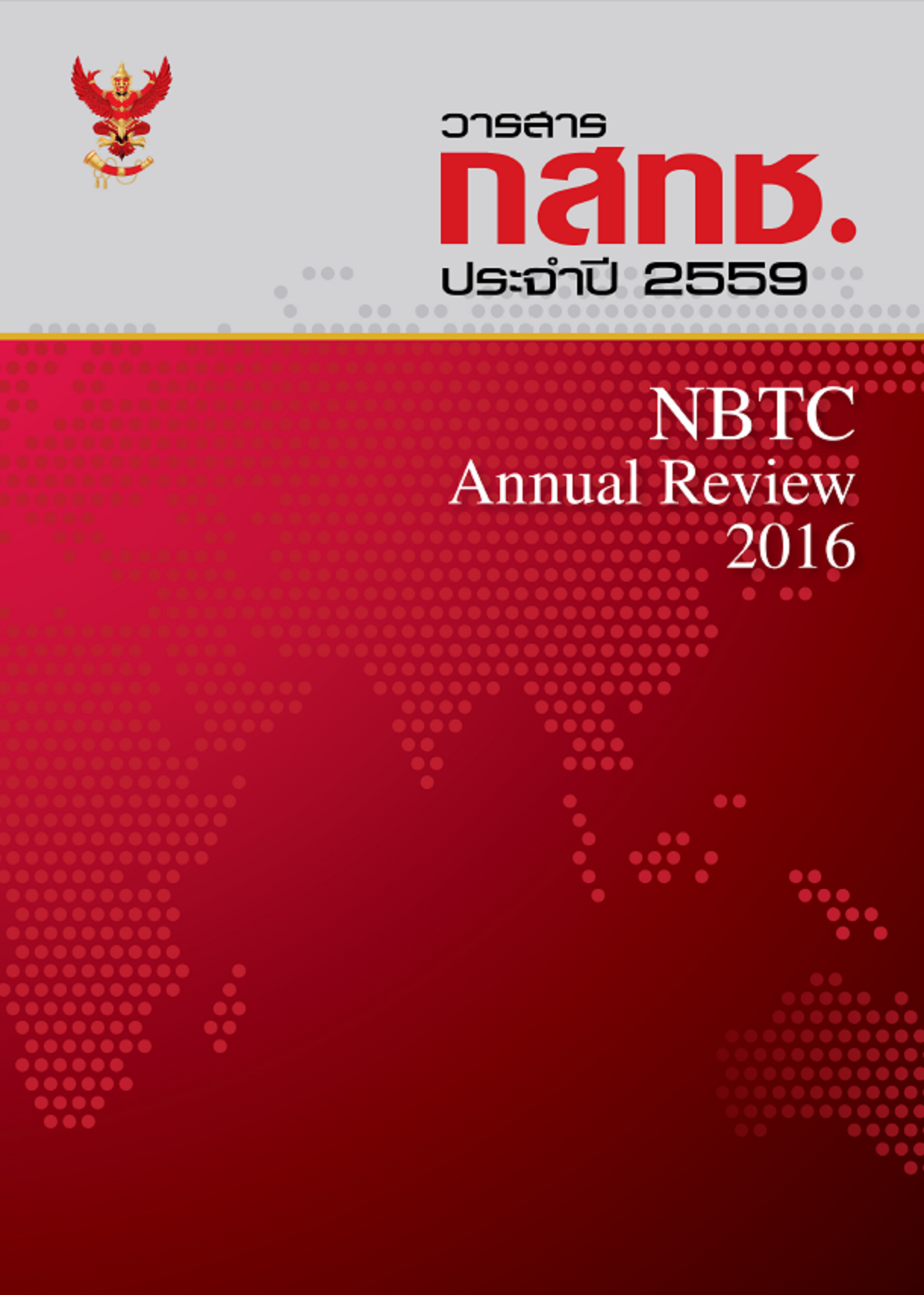MEDIA EXPOSURE AND SATISFACTION TOWARDS THE DIGITAL TELEVISION TRANSITION OF PEOPLE IN BANGKOK METROPOLITAN
Keywords:
Exposure behavior, the satisfaction, Digital Television, the transitionAbstract
The objectives of research are to study (1) the media exposure behaviors in relation to the digital television transition, (2) the satisfaction with the digital television transition and (3) the correlation of demographic data and the satisfaction with the digital television transition. Questionnaires were used to collect data from 400 samples comprising 290 female (72.50%) and 110 male (27.50%). Regarding the media exposure behaviors, 46% of the respondents were aware of digital television through public relations and information from the National Broadcasting and Telecommunications Commission (NBTC) and 26.30 % of the respondents liked the digital television transition because of higher quality of picture and sound. Most of the respondents (33.40%) watched digital television through digital cable systems. In terms of information reception and the redemption of digital TV subsidy vouchers, it is found that 34.50% of the respondents redeemed free Set Top Boxes and 16.20% of the respondents watched 3 HD at most. The favorite programs were dramas (23.80%) and most of the respondents watched digital television everyday (50.50%). Gender had an influence on the satisfaction of the digital television transition regarding the quality of exposure. Different ages significantly influenced the satisfaction at 0.05 levels with the digital television transition regarding the following spheres ; the NBTC’s encouragement on digital television by distributing digital television subsidy vouchers, providing information about digital television by NBTC, and the format and content of programs.
References
กาญจนา แก้วเทพ.(2547). ทฤษฎีและพฤติกรรมการสื่อสาร (พิมพ์ครั้งที่ 2). นนทบุรี:มหาวิทยาลัยสุโขทัยธรรมาธิราช.
กาญจนา วานิชกรและคณะ. (2552). โครงการศึกษาวิจัยแนวทางการจัดทำนโยบายการเปลี่ยนผ่านสู่ระบบโทรทัศน์ดิจิทัลสำหรับ
ประเทศไทย. กรุงเทพฯ:ศูนย์เทคโนโลยีอิเล็กทรอนิกส์และคอมพิวเตอร์แห่งชาติ.
นที สกุลรัตน์ [ออนไลน์] บทความวิชาการ. สืบค้นจาก https://www.drnatee.com/เมื่อวันที่ 16 มีนาคม 2558.
ภาสกร เรืองรองและคณะ (2557) โทรทัศน์ดิจิทัล (Digital Television) วารสารเทคโนโลยีการศึกษาและมีเดียคอนเวอร์เจนซ์,
ปีที่1 ฉบับที่ 1 (มกราคม-มิถุนายน 2557), หน้า 19-38.
ปรมะ สตะเวทิน. (2546). การสื่อสารมวลชน:กระบวนการและทฤษฎี. พิมพ์ครั้งที่ 3 กรุงเทพฯ:ภาพพิมพ์.
สมทบ เติมบุญบารมี. (2557). พฤติกรรมการรับชมโทรทัศน์ก่อนเข้าสู่ยุคดิจิทัล. กรุงเทพฯ:เอกสารการประเมินผลผลิตรายการ
อาวุโส สำนักรายการ Thai PBS.
สำนักงานการศึกษา กรุงเทพมหานคร. (2558). กลุ่มเขตกรุงเทพมหานคร.สืบค้นจาก https://www.bangkokeducation.in.th/
article-details.php?id=89เมื่อวันที่ 16 มีนาคม 2558.
สำนักงานคณะกรรมการกิจการกระจายเสียง กิจการโทรทัศน์ และกิจการโทรคมนาคมแห่งชาติ (กสทช.). (2557). แนวโน้มการให้
บริการทีวีดิจิทัลในปี 2557. สืบค้นที่ : https://bcp.nbtc.go.th/news/detail/1446. เมื่อวันที่ 1 มีนาคม 2558.
สำนักงานคณะกรรมการกิจการกระจายเสียง กิจการโทรทัศน์และกิจการโทรคมนาคมแห่งชาติ (กสทช.). (ม.ม.ป.) บทความดิจิทัล
ทีวี. สืบค้นที่ https://digital.nbtc.go.th/people.php เมื่อวันที่ 5 กุมภาพันธ์ 2558.
สำนักงานคณะกรรมการกิจการกระจายสียง กิจการโทรทัศน์และกิจการโทรคมนาคมแห่งชาติ. (2558) ประกาศแผนการเปลี่ยน
ระบบการรับส่งสัญญาณวิทยุโทรทัศน์เป็นระบบดิจิทัล สืบค้นที่ https://www.supinya.com/wp-content/uploads/2013/05
เมื่อวันที่ 1 มีนาคม 2558.
สำนักงานคณะกรรมการกิจการกระจายสียง กิจการโทรทัศน์และกิจการโทรคมนาคมแห่งชาติ. (กสทช.) (2557). “รู้จักสื่อรู้จัก
สิทธิ.” วารสารสำหรับผู้บริโภคสื่อวิทยุ – โทรทัศน์. ปีที่ 2 เล่มที่ 10 กรกฎาคม – สิงหาคม.
สำนักยุทธศาสตร์และประเมินผล.(2557). สถิติกรุงเทพมหานคร. สืบค้นจาก https://www.bangkok.go.th/upload/user/
/Logo/statistic/stat2557(thai).pdf เมื่อวันที่ 1 มีนาคม 2558.
สถานีวิทยุโทรทัศน์กองทัพบก ช่อง 5. (2557). การเปลี่ยนผ่านสู่โทรทัศน์ระบบดิจิทัล. แผนกเทคนิคโทรทัศน์ ทน.ททบ. สืบค้น
จาก https://www.tv5.co.th/technics/tv_digital_in_the_future.html เมื่อวันที่ 5 กุมภาพันธ์ 2558.
สุรพงษ์ โสธนะเสถียร. (2533). การสื่อสารกับสังคม. กรุงเทพฯ: จุฬาลงกรณ์มหาวิทยาลัย.
อิสรีย์ ประดิษฐ์ธีระ. (2555).ความเหลื่อมล้ำของระบบโทรทัศน์ดิจิทัลในประเทศไทยกับการเปลี่ยนผ่านสู่ระบบ โทรทัศน์ดิจิทัล
ของประชาคมอาเซียน. วารสารวิชาการสมาคมสถาบันอุดมศึกษาเอกชนแห่งประเทศไทย (สสอท.) ปีที่ 18 ฉบับที่ 2
พฤษภาคม 2555 หน้า 199-211.
Katz, E.,J.G. Blumler and M. Gurevitch.(1974). "Uses and gratifications research." Public Opinion Q. 37: 509-523.
Klapper, J. T. (1960). The effects of mass communication. New York: The free.
Downloads
Published
How to Cite
Issue
Section
License
The Office of the NBTC holds the copyright of articles appearing in the journal. The Office of the NBTC allows the public or individuals to distribute, copy, or republish the work under a Creative Commons license (CC), with attribution (BY), No Derivatives (ND) and NonCommercial (NC); unless written permission is received from the Office of the NBTC.
Text, tables, and figures that appear in articles accepted for publication in this journal are personal opinion and responsibility of the author, and not binding on the NBTC and the Office of the NBTC. In case of errors, each author is solely responsible for their own article, and not concerning the NBTC and the NBTC Office in any way.



